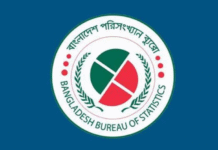
The Bangladesh Bank is rowing back on the monetary policy it adopted to curb aggressive lending as it now wants to ease liquidity crisis in banks in the year of general elections.
Former governor Salehuddin Ahmed says the central bank decisions on relaxing cash reserve requirement or CRR along with cutting repo interest rate ‘following pressure from the bank owners’ run against the monetary policy it announced at the end of January.
South Asian Network on Economic Modelling or SANEM Executive Director Prof Selim Raihan has warned the government such decisions may aggravate the instability in the banking sector.
Debashish Chakraborty, an executive director and spokesperson for the Bangladesh Bank, however, denies there was ‘pressure’ on them.
He, instead, claims the central bank made the decisions to help the government achieve the GDP growth target.
The changes come at a time when irregularities amounting to tens of millions of taka have thrown the Farmers Bank, launched only four years ago on political considerations, into deep trouble.
Many ask whether money being laundered abroad before the election is causing the liquidity crisis in the banks.
Finance Minister AMA Muhith and Bangladesh Bank Governor Fazle Kabir sat with the Bangladesh Association of Banks or BAB, the body of the owners and entrepreneurs of the sector, at a Dhaka Hotel on Sunday.
The way Muhith and Kabir decided to reduce CRR and repo rates in the meeting has raised a few eyebrows.

Sheikh Hasina invited bank owners to the Ganabhaban on Tuesday.
The members of BAB along with the families met Prime Minister Sheikh Hasina at a Ganabhaban event on Tuesday.Hours before the event, the central bank issued a circular, cutting the CRR by 1 percentage point to 5.5 percent. The decision will go into force from Apr 15.
| Also read
Bangladesh Bank lowers repo rate, sets CRR at 5.5% Govt to relax cash reserve ratio at banks to ease liquidity crisis Private banks will receive half of government deposits: Muhith |
Cash reserve ratio or CRR, also called cash reserve requirement, is a minimum fraction of the total deposits of customers, which commercial banks have to hold as reserves either in cash or as deposits with the central bank.
The repo interest rate determines the rate of interest a commercial bank has to pay on loan from the Bangladesh Bank.
The central bank has cut the rate from 6.75 percent to 6 percent.
The reverse repo interest rate, which determines the interest rate the central bank pays on loans from commercial banks, has remained unchanged at 4.75 percent.
The central bank controls liquidity and flow of investment with these rates called policy tools.
Cuts in the repo interest rate and CRR mean the Bangladesh Bank has eased the way for the banks to keep more cash.
Economists estimate only the drop in CRR will allow Tk 100 billion into the banks.
The central bank uses CRR to safeguard depositors’ money. The Awami League government raised the CRR from 6 percent to 6.5 percent after it won the 2014 elections.
Now, it has also decided to double its deposits in the private banks.
According to the rules, 75 percent of government institution assets are currently kept at state-run banks.
Managing directors and chairmen from private banks have long asked the government to make larger deposits at their institutions.
Muhith recently said the government would soon start keeping 50 percent of its assets in private banks.
All these decisions before the settlement of the Farmers Bank issue have surprised analysts.
Around Tk 5.08 billion of the government’s Climate Change Trust fund is stuck in the troubled bank opened by ruling Awami League MP Muhiuddin Khan Alamgir.
The bank, unable to get back loans disbursed amidst irregularities, cannot return the deposits of its customers now.

The monetary policy for the second half of 2017-18 fiscal year was announced on Jan 29.
In the monetary policy for the second half of the fiscal year, the central bank rolled out a series of measures to curb ‘overexuberance in lending’.The ceiling for the advance-to-deposit ratio or ADR that measures loans as a percentage of deposits for commercial banks has been revised down by 1.5 percentage points to 83.5 percent. For Islamic banks, it has been cut by 1 percentage point to 89 percent.
It means the banks had been able to lend up to Tk 82 when it had Tk 100 in deposits. Now they can lend up to Tk 83.5 against total deposits of Tk 100 while the Islamic banks can lend up to Tk 89.
After the new ADR rates were announced, the banks started to collect deposits by raising interest rates to continue aggressive lending.
Later the central bank extended the time to adjust ADR by six months to Dec 31 to allow the banks to rein in an aggressive drive of the collection of deposits by offering high interest rates.

Former Bangladesh Bank governor Salehuddin Ahmed. File Photo
Former governor Salehuddin says the cuts in repo rates and CRR have rendered ‘meaningless’ the central bank’s measures to control aggressive lending.“It wasn’t proper in any way to cut important tools of the economy like CRR and repo interest rate at a meeting in a hotel. It contradicts the monetary policy,” he told bdnews24.com.
In his view, although the central bank announced a contractionary monetary policy, cutting the CRR and repo interest rates will allow more money into the market and it will spike inflation.
“The increased flow of cash will lead the banks to lend money without checking the borrowers. This will raise the amount of bad loan. The crisis will deepen,” he warned.
The former Bangladesh Bank chief believes the situation over the liquidity crisis in the banks is not as bad as people make it out to be.
“The situation is bad in one or two banks. Separate steps can be taken for these. But this crisis doesn’t justify the blanket cuts in CRR and repo interest rate for all the banks,” he said.
Salehuddin says it is ‘clear’ the changes were made after the bank owners exerted pressure.
“The Bangladesh Bank announced the monetary policy a few days ago. It could have cut the rates at the time. But doing these things now under pressure from the bank owners is not reasonable,” he said.

SANEM Executive Director Prof Selim Raihan speaks at the media conference.
SANEM organised a news conference in Dhaka on Wednesday to react to the central bank decisions.The research organisation’s Executive Director Prof Raihan said, “The two decisions were not taken in a proper manner. Bangladesh Bank has its policymaking unit. They could have taken the decisions after discussions among themselves, but this did not happen.
“More surprisingly, the decisions were taken following pressure from the banks.”
He said the central bank decisions would send a ‘wrong message’ to the entire financial sector.
“There is no guarantee that the banks with bad performance will not misuse the money if they are given more now,” he said.
He fears the failure to punish the loan defaulters due to the central bank’s ‘weak control’ will lead to even more bad loan.
Reached for comments, Bangladesh Bank spokesperson Debashish said, “I don’t understand why these questions have been raised.”
“CRR and repo interest rate have been cut to help the government achieve the targeted growth, not because of any other reason such as pressure,” he told bdnews24.com.
Debashish also said Financial Institutions Division under the finance ministry and the Bangladesh Bank supplement each other.
“The government has announced Vision 2021 and Vision 2041 and the central bank is assisting the government to actualise them,” he said.
Source: BDnews24.









